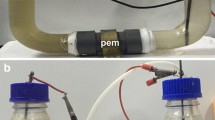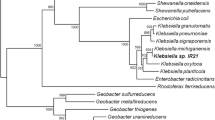Abstract
In microbial fuel cell (MFC), the rate of electron transfer to anode electrode is a key intrinsic limiting factor on the power output of MFCs. Using Klebsiella pneumoniae (K. pneumoniae) strain L17 as biocatalyst, we studied the mechanism of electron shuttle via self-producing mediator in a cubic air-chamber MFC. To eliminate the influence of biofilm mechanism, the anode electrode was coated with microfiltration membrane (0.22 μm). Data showed that the microfiltration membrane coated and uncoated MFCs achieved the maximum voltage outputs of 316.2 and 426.2 mV after 270 and 120 h, respectively. When the medium was replaced in MFCs that had the highest power generation, the power output dropped by 62.1% and 8.8%, and required 120 and 48 h to resume the original level in the coated and uncoated MFCs, respectively. The results suggested an electron-shuttle mechanism rather than biofilm mechanism was responsible for electricity generation in the membrane coated MFC. Cyclic voltammetric measurements demonstrated the presence of an electrochemical active compound produced by K. pneumoniae strain L17, which was identified to be 2,6-di-tert-butyl-p-benzoquinon (2,6-DTBBQ) by GC-MS. 2,6-DTBBQ, as a recyclable electron shuttle, could transfer electrons between K. pneumoniae L17 and the anode electrode.
Similar content being viewed by others
References
Park D H, Zeikus J G. Improved fuel cell and electrode designs for producing electricity from microbial degradation. Biotechnol Bioeng, 2003, 81: 348–355
Gil G C, Chang I S, Kim B H, et al. Operational parameters affecting the performance of a mediator-less microbial fuel cell. Biosens Bioelectron, 2003, 18: 327–334
Bond D R, Lovley D R. Electricity production by Geobacter sulfurreducens attached to electrodes. Appl Environ Microbiol, 2003, 69: 1548–1555
Chaudhuri S K, Lovley D R. Electricity generation by direct oxidation of glucose in mediatorless microbial fuel cells. Nat Biotechnol, 2003, 21: 1229–1232
Reguera G, Carthy K D, Mehta T, et al. Extracellular electron transfer via microbial nanowires. Nature, 2005, 435: 1098–1101
Gorby Y A, Beveridge T J. Composition, reactivity, and regulation of extracellular metal-reducing structures (nanowires) produced by dissimilatory metal reducing bacteria, 2005, Warrenton, VA
Wrighton K C, Agbo P, Warnecke F, et al. A novel ecological role of the Firmicutes identified in thermophilic microbial fuel cells. ISME J, 2008, 2: 1146–1156
Rabaey K, Boon N, Siciliano S D, et al. Biofuel cells select for microbial consortia that self-mediate electron transfer. Appl Environ Microbiol, 2004, 70: 5373–5382
Rabaey K, Boon N, Hofte M, et al. Microbial phenazine production enhances electron transfer in biofuel cells. Environ Sci Technol, 2005, 39: 3401–3408
Marsili E, Baron D B, Shikhar I D, et al. Shewanella secretes flavins that mediate extracellular electron transfer. Proc Nat Acad Sci USA, 2008, 105: 3968–397
Zhang L X, Zhou S G, Zhuang L, et al. Microbial fuel cell based on Klebsiella pneumoniae biofilm. Electrochem Commun, 2008, 10: 1641–1643
Li X M, Zhou S G, Li F B, et al. Fe (III) oxides reduction and carbon tetrachloride dechlorination by a newly isolated Klebsiella pneumoniae strain L17. J Appl Microbiol, 2009, 106: 130–139
Zhang L X, Liu C S, Zhuang L, et al. Manganese dioxide as an alternative cathodic catalyst to platinum in microbial fuel cells. Biosens Bioelectron, 2009, 24: 2825–2829
Lovley D R, Phillips E J P. Novel mode of microbial energy metabolism: Organism carbon oxidation coupled to dissimilatory reduction of iron and manganese. Appl Environ Microbiol, 1988, 54: 1472–1480
Bond D R, lovley D R. Evidence for involvement of an electron shuttle in electricity production by Geothrix fermentans. Appl Environ Microbio, 2005, 71: 2186–2189
Lovley D R. Bug juice: Harvesting electricity with microorganisms. Nat Rev (Microbiology), 2006, 4: 497–508
Newman D K, Kolter R. A role for excreted quinones in extracellular electron transfer. Nature, 2000, 405: 94–97
Rau J, Knackmuss H J, Stolz A. Effects of different quinoide redox mediators on the anaerobic reduction of azo dyes by bacteria. Environ Sci Technol, 2002, 36: 1497–504
Keck A, Rau J, Reemtsma T, et al. Identification of quinoide redox mediators that are formed during the degradation of Naphthalene-2-Sulfonate by Sphingomonas xenophaga BN6. Appl Environ Microbiol, 2002, 68: 4341–4349
Dos Santos A B, Cervantes F J, Yaya-Beas R E, et al. Effect of redox mediator, AQDS, on the decolourisation of a reactive azo dye containing triazine group in a thermophilic anaerobic EGSB reactor. Enzyme Microb Tech, 2003, 33: 942–951
Author information
Authors and Affiliations
Corresponding author
Additional information
This work was supported by the National Natural Science Foundation of China (No. 20777013), Natural Science Foundation of Guangdong Province, China (No. 07006759) and The Sci & Tech Innovation project of Guangdong Academy of Sciences, China (Gtard No. CX200704).
About this article
Cite this article
Deng, L., Li, F., Zhou, S. et al. A study of electron-shuttle mechanism in Klebsiella pneumoniae based-microbial fuel cells. Chin. Sci. Bull. 55, 99–104 (2010). https://doi.org/10.1007/s11434-009-0563-y
Received:
Accepted:
Published:
Issue Date:
DOI: https://doi.org/10.1007/s11434-009-0563-y




